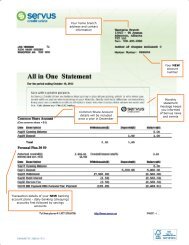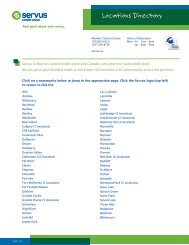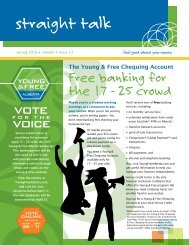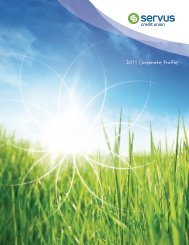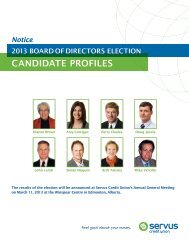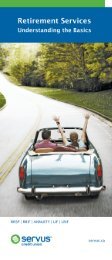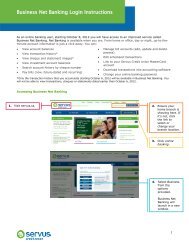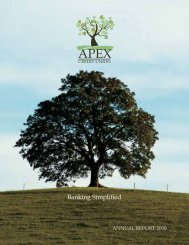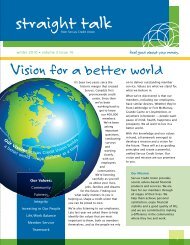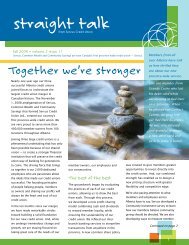Planning for your retirement - Servus Credit Union
Planning for your retirement - Servus Credit Union
Planning for your retirement - Servus Credit Union
You also want an ePaper? Increase the reach of your titles
YUMPU automatically turns print PDFs into web optimized ePapers that Google loves.
How to Begin <strong>Planning</strong>There are three basic areas to consider in planning<strong>for</strong> <strong>retirement</strong>:• Your finances, including <strong>your</strong> needs, and resources suchas savings, investments, and pension income,• Your proposed <strong>retirement</strong> age,• Your personal goals and planning activities <strong>for</strong> <strong>retirement</strong>.Personal values affect these considerations, so planningshould be a family matter.To help you through the planning process, <strong>your</strong> creditunion offers this booklet. Whether you’re fast approaching<strong>retirement</strong>, or whether you’re starting now on a long-termplan <strong>for</strong> <strong>your</strong> future, you’ll find useful in<strong>for</strong>mation andadvice here.Use of the Term “Spouse”Throughout this booklet, the term “spouse” includes otherindividuals who have been given similar rights under theapplicable legislation.Determining YourFinancial NeedsConsiderable energy and ef<strong>for</strong>t goes into developing a social“safety net” <strong>for</strong> retired people in Canada. Governmentsprovide publicly funded pensions, set standards <strong>for</strong> privatepension plans, and offer tax incentives <strong>for</strong> pension saving.Employers design and fund employee pension plans. Awhole financial planning industry is available to provideadvice and services.Nevertheless, it’s up to you to provide <strong>for</strong> <strong>your</strong> own financialsecurity by setting <strong>your</strong> long-term <strong>retirement</strong> goals anddeveloping a plan <strong>for</strong> achieving them.The first step in any plan is determining where you are andwhere you want to be. This means analyzing <strong>your</strong> presentfinancial position and projecting it to the time in the futurewhen you want to retire.As part of <strong>your</strong> plan, you must determine <strong>your</strong> needs during<strong>retirement</strong>, considering such things as <strong>your</strong> spending habits,whether you’ll own or rent <strong>your</strong> home, and how much of areserve you’ll want <strong>for</strong> unexpected expenses.PLANNING FOR YOUR RETIREMENT 3
Here’s Where Retirement IncomeComes FromYour employer’s pension payment $Your spouse’s employer’s pension payment $Your Canada Pension Plan $Your spouse’s Canada Pension Plan $Your Old Age Security $Your spouse’s Old Age Security $Your Guaranteed Income Supplement $Your spouse’s Guaranteed Income Supplement $Your RRSP <strong>retirement</strong> income $Your spouse’s RRSP <strong>retirement</strong> income $Profit-sharing fund payout $Any earned income in <strong>retirement</strong>, salaryexpectedRental income (net) $Any other fees, payments <strong>for</strong> services $Disability and/or endowment/insurancepaymentsBusiness or real estate income $Savings account interest (credit union, bank,trust co.)Canada Savings Bond interest $Term deposits, guaranteed investmentcertificate interestTax-Free Savings Accounts (TFSA)* $Income from stocks, bonds, mutual funds, etc. $Investment income from any expectedinheritanceOther net worth property, investments,which you expect to create incomeOther income sources: alimony; social welfare;disability insurance; EITOTAL EXPECTED MONTHLY INCOME $Your EstimatedMonthlyRetirement Income$$$$$$$* The TFSA is another tax sheltered product <strong>for</strong> investment earnings and gains.Unlike RRSPs, withdrawals of contributions and income/gains are not taxable.The TFSAs are available since 2009. Contact <strong>your</strong> <strong>Credit</strong> <strong>Union</strong> <strong>for</strong> additionalin<strong>for</strong>mation on this registered product.4PLANNING FOR YOUR RETIREMENT
Here’s WhereRetirement Income GoesEstimate Your Monthly Cost of LivingBudget Need:(excluding savingsand income taxes)Food:(including meals out)Housing:(utilities, rent/mortgage, furnishings,property taxes,maintenance,homeowner’sinsurance)Transportation:(gasoline, autoinsurance, licence,maintenance, publictransportation)Clothing & PersonalCare: (dry cleaning,cosmetics, toiletries)Medical Care:(drugs, dental, healthinsurance, othermedical expenses)Entertainment:(recreation, books,magazines)Other Items:(gifts, donations,life insurance)TOTALS$MonthlyNeedNow$AnnuallyNeeded inRetirement$Monthly$AnnuallyPLANNING FOR YOUR RETIREMENT 5
Strategies <strong>for</strong> SavingWithout a definite savings strategy, most people find itdifficult to save. The trick is to build saving into <strong>your</strong> budget,rather than leaving it as an afterthought. If the cash has away of disappearing be<strong>for</strong>e it reaches <strong>your</strong> savings account,try a payroll savings plan so that the money can’t take adetour. Make sure you’re realistic about <strong>your</strong> savings budget– if you aim too high, you’ll soon find <strong>your</strong> good intentionsare unworkable.You can earn the best return on <strong>your</strong> money by followinga few basic techniques:• Channel all idle money into a savings account that willearn interest, even if only <strong>for</strong> a few days or weeks. Forexample, if you make monthly mortgage and car loanpayments, keep the funds in a daily interest savingsaccount and transfer them to chequing just be<strong>for</strong>e <strong>your</strong>payments are due (check first to make sure transfer costsdon’t apply). Or use a chequing savings account.• Transfer savings that won’t immediately be needed from<strong>your</strong> regular savings account into higher-paying termdeposits or a high interest savings account. To cover<strong>your</strong>self in emergencies, stagger the maturity dates of theterm deposits so that one is always coming due shortly.The cornerstone of many <strong>retirement</strong> savings strategiesis to put <strong>your</strong> savings into a registered <strong>retirement</strong> savingsplan (RRSP).RRSPs are designed specifically to help you save <strong>for</strong> <strong>your</strong><strong>retirement</strong>. Qualifying contributions made to an RRSP canbe claimed as a tax deduction. No tax is paid on the interestand other income earned from these contributions untilthe funds are withdrawn. At <strong>retirement</strong>, the funds held in<strong>your</strong> RRSP can be converted to <strong>your</strong> own personal pension.This pension can take the <strong>for</strong>m of a Registered RetirementIncome Fund, Life Annuity or Term Certain Annuity. Forfurther in<strong>for</strong>mation about RRSPs, refer to the credit unionbooklet: Understanding All The Basics – RRSP, RRIF,ANNUITY, LIF, LRIF.Another <strong>retirement</strong> savings vehicle is the Tax-Free SavingsAccount (TFSA). This registered product has been availablesince 2009. Unlike RRSPs, the contribution limit is not tiedto <strong>your</strong> income and the contributions are not tax deductible.Interest and other income earned on the contributionsaccumulate tax-sheltered. A withdrawal of contributions and/or income is not taxable. For further in<strong>for</strong>mation, contact<strong>your</strong> credit union or refer to the credit union leaflet: Tax-FreeSavings Account: A Fresh Approach to Your Savings.6PLANNING FOR YOUR RETIREMENT
Savings ultimately are not only a source of financialsecurity, they also earn income <strong>for</strong> you. The following chartdemonstrates the amount of savings that you need toaccumulate to produce a specific monthly income at variousrates of interest. For example, to earn $200 per month wheninterest rates are 4% requires $60,000 of savings.AnnualInterest RateMonthly Income Earned% $100 $200 $350 $500 $1000REQUIRED SAVINGS AND INVESTMENTS (IN THOUSANDS)3.00%3.25%3.50%3.75%40.0036.9234.2932.0080.0073.8568.5764.00140.00129.23120.00112.00200.00184.62171.43160.00400.00369.23342.86320.004.00%4.25%4.50%4.75%30.0028.2426.6725.2660.0056.4753.3350.53105.0098.8293.3388.42150.00141.18133.33126.32300.00282.35266.67252.635.00%5.25%5.50%5.75%24.0022.8621.8220.8748.0045.7143.6441.7484.0080.0076.3673.04120.00114.29109.09104.35240.00228.57218.18208.706.00%6.25%6.50%6.75%20.0019.2018.4617.7840.0038.4036.9235.5670.0067.2064.6262.22100.0096.0092.3188.89200.00192.00184.62177.787.00%7.25%7.50%7.75%17.1416.5516.0015.4834.2933.1032.0030.9760.0057.9356.0054.1985.7182.7680.0077.42171.43165.52160.00154.848.00%8.25%8.50%8.75%15.0014.5514.1213.7130.0029.0928.2427.4352.5050.9149.4148.0075.0072.7370.5968.57150.00145.45141.18137.149.00%9.25%9.50%9.75%13.3312.9712.6312.3126.6725.9525.2624.6246.6745.4144.2143.0866.6764.8663.1661.54133.33129.73126.32123.0810.00%10.25%10.50%10.75%12.0011.7111.4311.1624.0023.4122.8622.3342.0040.9840.0039.0760.0058.5457.1455.81120.00117.07114.29111.63PLANNING FOR YOUR RETIREMENT 7
Investing <strong>for</strong> ProfitSuccessfully investing <strong>your</strong> savings takes thought. Do itin a hit-or-miss way and you’ll end up with a mismatch ofsecurities that has no relation to <strong>your</strong> objectives. A wellplannedapproach to investing, on the other hand, canbe a profitable way to provide <strong>for</strong> <strong>your</strong> <strong>retirement</strong>.Fundamental steps to success include:DiversifyDon’t put all <strong>your</strong> savings in one type of investment. Whilefixed term investments such as term deposits, guaranteedinvestment certificates (GICs), Canada Savings Bonds orprovincial savings bonds will give you a guaranteed rate ofreturn, their value will be eroded by inflation. It is desirable tohave a portion of <strong>your</strong> portfolio in investments that increasein value, such as mutual funds or stocks.For the small investor, mutual funds are the simplest wayto diversify. They generally increase in value over time,but are not a method of getting rich quick. Because theymay decrease in value on a temporary or permanent basis,people usually invest only a portion of their savings inmutual funds.Learn the Risks InvolvedEvery investment entails some degree of risk. Ask questionsbe<strong>for</strong>e you invest.Deposits at <strong>your</strong> credit union, trust company or bank arecovered by deposit insurance to varying degrees. CanadaSavings Bonds are guaranteed by the government ofCanada. Other bond values can fluctuate considerably withinterest rate changes.Real estate has been a profitable investment in many partsof the country. But property values can be affected byfactors beyond <strong>your</strong> control – mortgage rates, local businessconditions, re-zoning, etc. Adding to its appeal is the fact thatincreases in value are considered capital gains, qualifying <strong>for</strong>favourable income tax treatment.Shares and equity mutual funds offer the best opportunity<strong>for</strong> long-term growth because there’s no limit to their futurevalue or earnings. However, these investments carry morerisk, and there are no guarantees.8PLANNING FOR YOUR RETIREMENT
Match Your Investments to Your ObjectivesYour investment strategy will change with <strong>your</strong>circumstances. When saving <strong>for</strong> a downpayment on ahome or university expenses only a short time away, mostpeople will use term deposits or bonds that will maturewhen needed. You would not want to try stocks or riskytypes of mutual funds in case they have a low value whenneeded. For long-range goals such as <strong>retirement</strong>, you cantake more risks in stocks or mutual funds. As you get closerto <strong>retirement</strong> age, you can shift <strong>your</strong> portfolio to less riskyinvestments.Time Your InvestmentsInterest rates rise and fall over time. You don’t want all of<strong>your</strong> term deposits to mature at once, in case that is a timewhen interest rates are low. Choose a variety of terms (oneto five years) and maturity dates.The following worksheets will help you keep track of andupdate <strong>your</strong> savings and investment program.PLANNING FOR YOUR RETIREMENT 9
Worksheet <strong>for</strong> <strong>Planning</strong> Your Savings and Investment Program– Present Holdings –AMOUNTSAVED ORINVESTED IN:$ $PRESENTANNUAL YIELDIN DOLLARSLOCATION OFSECURITIESOR DEPOSITSTOTAL$ $AVERAGE YIELD IN % (DOLLAR YIELD ÷ AMOUNT X 100) =OTHER ASSETSTOTAL$ $10PLANNING FOR YOUR RETIREMENT
Worksheet <strong>for</strong> <strong>Planning</strong> Your Savings and Investment Program– Present Holdings –AMOUNTSAVED ORINVESTED IN:$ $PRESENTANNUAL YIELDIN DOLLARSLOCATION OFSECURITIESOR DEPOSITSTOTAL$ $AVERAGE YIELD IN % (DOLLAR YIELD ÷ AMOUNT X 100) =OTHER ASSETSTOTAL$ $PLANNING FOR YOUR RETIREMENT 11
Public Pension PlansA number of government programs provide <strong>retirement</strong>income. Specific provisions of these programs are subjectto change – <strong>for</strong> more in<strong>for</strong>mation, check with Employmentand Social Development Canada, “Pensions”, in the federalgovernment section of <strong>your</strong> telephone directory, or online athttp://www.esdc.gc.ca/eng/<strong>retirement</strong>/index.shtml.Canada Pension Plan (CPP)Everyone employed or self-employed in Canada is required tomake payments to the CPP. Retirement benefits are providedby the plan if you have made contributions <strong>for</strong> at least oneyear. The amount of <strong>your</strong> pension depends on <strong>your</strong> incomelevel while contributing to CPP and the number of years youcontributed. The benefits are indexed annually based on thefederal cost of living index.Starting in 2012, contributors no longer have to stop workingor significantly reduce earnings <strong>for</strong> two consecutive monthsto receive the CPP <strong>retirement</strong> pension be<strong>for</strong>e the age of65. This will make it easier <strong>for</strong> Canadians to make a gradualtransition to <strong>retirement</strong>.Most people begin receiving benefits on their 65th birthday.However, you may start receiving CPP payments as early asage 60. From 2012 to 2016, the Government will graduallychange this early pension reduction from 0.5% to 0.6% permonth. This means that by 2016, an individual who startsreceiving their CPP pension at the age of 60 will receive 36%less than if they had taken it at 65.You may also delay receiving <strong>your</strong> pension until as late as<strong>your</strong> 70th birthday. If you take <strong>your</strong> pension after age 65,<strong>your</strong> monthly pension will be increased by 0.7% <strong>for</strong> eachmonth (8.4% per year) that you delay receiving <strong>your</strong> paymentup to age 70. This means that an individual who startsreceiving their CPP pension at the age of 70 will receive42% more than if they had taken it at 65.CPP also pays survivor benefits to a spouse and dependentchildren and benefits to you and <strong>your</strong> dependent children ifyou are disabled.You must apply to receive benefits. Do this several monthsin advance, because retroactive payments are not made.12PLANNING FOR YOUR RETIREMENT
Old Age Security (OAS)People 65 and over who are eligible under residencerequirements also receive a monthly pension from thefederal government. The amount is adjusted quarterly, inJanuary, April, July and October, based on the federal costof living index. You should apply <strong>for</strong> benefits several monthsbe<strong>for</strong>e you turn 65 to ensure <strong>your</strong> payments begin on time.The 2014 annual amount is approximately $6,618.48 (April2014 maximum monthly payment $551.54). An individualwith net income above $71,592 must repay part or all ofthe maximum OAS amount. The repayment amounts arenormally deducted from the monthly payments be<strong>for</strong>e itis issued. The full OAS is eliminated when an individual’snet income is $115,716 or above.Guaranteed Income Supplement (GIS)If you are 65 or over, have little income other than the OldAge Security, and live in Canada, you are eligible <strong>for</strong> GIS.This supplement is adjusted quarterly based on the federalcost of living index, but benefits do not decrease if the indexdrops. When <strong>your</strong> OAS application is approved, you will besent an application <strong>for</strong> GIS.OAS Spouse’s AllowanceAn OAS pensioner’s spouse may be eligible <strong>for</strong> a Spouse’sAllowance if the spouse is between the ages of 60 and65 years of age and meets OAS residence requirements.The amount is based on the combined monthly income ofthe couple. If <strong>your</strong> spouse is between the ages of 59 1/2and 65, an application <strong>for</strong> Spouse’s Allowance willautomatically be mailed to you with <strong>your</strong> GuaranteedIncome Supplement application.Provincial Government ProgramsAdditional <strong>retirement</strong> supplements are available fromprovincial governments. These vary from province toprovince – ask <strong>your</strong> provincial government in<strong>for</strong>mationcentre <strong>for</strong> more in<strong>for</strong>mation.PLANNING FOR YOUR RETIREMENT 13
Private Pension PlansPrivate pension plans – usually called registered pensionplans – are established by employers <strong>for</strong> their employees.Registered pension plans take the <strong>for</strong>m of either moneypurchase plans or defined benefit plans. Each has its ownadvantages and disadvantages you should be aware ofin making decisions about <strong>your</strong> <strong>retirement</strong>.Money Purchase PlansMoney purchase plans (sometimes called definedcontribution plans) link pension benefits to contributionsmade to the plan during <strong>your</strong> employment. Thecontributions, together with accumulated earnings, are usedto purchase a pension <strong>for</strong> you at <strong>retirement</strong>. The size of thepension will depend on the amount of money in <strong>your</strong> fundat <strong>retirement</strong> and the annuity yields available at the time.The pension contributions are usually calculated as apercentage of earnings and are paid by you and <strong>your</strong>employer or sometimes by <strong>your</strong> employer alone.Advantages of a Money Purchase Plan are:• The plan is simple <strong>for</strong> both employee and employerto understand.• The contribution required is always known by bothemployee and employer.• It’s easy to determine the amount due to an employeewho leaves the company be<strong>for</strong>e <strong>retirement</strong>.• Employers cannot withdraw any surplus.14PLANNING FOR YOUR RETIREMENT
Disadvantages of This Kind of Plan are:• Employees can only estimate their eventual pension, sinceit depends on the contributions accumulated to <strong>retirement</strong>,and the yields available at <strong>retirement</strong>.• Inflation may dramatically reduce the purchasing powerof accumulated funds – a problem with any plan that isn’tindexed to the cost of living.Defined Benefit PlanA defined benefit plan links pension benefits to earningsduring specific years of service. For example, <strong>your</strong> annualpension might be equal to 2% of <strong>your</strong> average annualearnings during <strong>your</strong> last five years of service, multiplied by<strong>your</strong> total years of service. Or it could be the average of <strong>your</strong>highest years of earnings. An actuary estimates the level ofcontributions by employer and employee needed to fund thebenefits. Any shortfall in the fund over the years must bemade up by the employer.Advantages are:• Because the eventual pension can be specificallycalculated, employees can carry out more accuratefinancial planning <strong>for</strong> their <strong>retirement</strong>.• The future pension rises with salary increases duringemployment, which helps lessen the effect of inflation.• The employer bears the risk of a shortfall in the fund.Disadvantages Include:• Employees who enter the plan at an early age andcontribute until they retire may fund their own pensionsentirely, with little or no benefit from employercontributions.• If pension benefits are tied to earnings many years be<strong>for</strong>e<strong>retirement</strong>, subsequent years of inflation could create asubstantial gap between an employee’s income just be<strong>for</strong>e<strong>retirement</strong> and pension income.• Employees retiring early may find their pension isbased on an income level too low to meet the effectsof later inflation.• Vesting and portability are more complicated thanin money purchase plans.PLANNING FOR YOUR RETIREMENT 15
Key Details about Registered Pension PlansIt’s important to be aware of certain details about thepension plan where you work, so you can make in<strong>for</strong>meddecisions in planning <strong>your</strong> <strong>retirement</strong>. Things to consider are:Vesting. Employer’s contributions are vested in anemployee when they belong to the employee and can’tbe retracted by the employer. If the employee leaves thecompany be<strong>for</strong>e full vesting, he or she loses part or all ofthe employer’s contributions. Vesting occurs over or aftera certain time period; an increasing number of plans provide<strong>for</strong> full vesting after two years, regardless of age.Locking in. Pension funds are locked in; an employeecannot withdraw them <strong>for</strong> any other use.Portability. A pension is portable if vested contributionscan be transferred to a new plan when an employee leavesthe job be<strong>for</strong>e <strong>retirement</strong>. In this case there are three mainalternatives: transfer to the new employer’s plan, transferto a registered <strong>retirement</strong> savings plan (part or all may belocked in), or leave the funds in the old plan to provide apension on <strong>retirement</strong>.Spouse’s Benefits. A pension plan should continuepayments to the spouse after an employee’s death. Manyplans pay the survivor at least 60% of the deceased’sentitlement.Early Retirement. Many plans provide <strong>for</strong> pension benefitsstarting as early as 55, but at a reduced level, because theyare made over a longer time period.Adjustments <strong>for</strong> Inflation. High inflation rates in the early1980’s seriously eroded many pensions. Ideally, a pensionplan provides benefit adjustments to compensate <strong>for</strong>inflation. Otherwise, the employer may or may not makevoluntary increases in pensions to compensate <strong>for</strong> inflation.Deferred Profit-Sharing PlansDeferred profit-sharing plans (DPSPs) are similar in manyways to registered pension plans. However, because theemployer’s contributions are based on company profits, nocontributions need be made in a loss year.Employer contributions are limited to half the contributionlimit <strong>for</strong> defined contribution registered pension plans.Amounts received from a DPSP must be included in <strong>your</strong>taxable income; be<strong>for</strong>e the end of the year you attain age 71you may transfer them to a RRSP, to a RRIF, or use them tobuy an annuity.16PLANNING FOR YOUR RETIREMENT
Personal Pension Plans –RRSPs and MoreBecause you make the decisions regarding them, personalpension plans – based on savings, registered <strong>retirement</strong>savings plans, or sometimes life insurance – give you themost flexibility in planning <strong>for</strong> <strong>your</strong> <strong>retirement</strong>.Registered Retirement Savings Plans (RRSPs) are one of themost popular personal plans. Contributions to <strong>your</strong> RRSP aretax deductible to allowable limits and the plan’s earnings aretax-sheltered. You pay tax only when you withdraw fundsfrom the RRSP – often at a lower rate after <strong>retirement</strong>.<strong>Credit</strong> unions, trust companies, life insurance companies,banks, investment brokers, and mutual fund companies alloffer RRSPs, with a choice of investment options.You may have any number of RRSPs, but <strong>your</strong> totaldeductible contributions can’t exceed specific limits basedon income, as set by government regulations. You may alsobe able to make contributions to a plan <strong>for</strong> <strong>your</strong> spouse,which can help reduce the family income tax in <strong>your</strong><strong>retirement</strong> years.RRSP Maturity OptionsYour RRSPs must mature be<strong>for</strong>e December 31 of the yearin which you reach age 71. This means you must make somearrangements by that date <strong>for</strong> <strong>your</strong> RRSP funds.Retirement income options include:• Transferring the RRSP funds to one or more RegisteredRetirement Income Funds (RRIFs).• Buying a Term Certain Annuity to age 90 (TCA 90)(also called Fixed Term Annuity – FTA).• Buying a life annuity.Or any combination of the above.If you don’t choose one of these <strong>retirement</strong> incomeoptions, you have the alternative of withdrawing <strong>your</strong> fundsin lump-sum amounts. These withdrawals will be subject toimmediate taxation at the applicable rates.You don’t have to have <strong>your</strong> RRIF or annuity with the sameinstitution as <strong>your</strong> RRSP – shop around <strong>for</strong> the best ratesand options.PLANNING FOR YOUR RETIREMENT 17
Registered Retirement Income Funds (RRIFs)RRIF payments are based on a schedule of <strong>your</strong> choice.Payments from a RRIF can continue throughout <strong>your</strong> or <strong>your</strong>spouse’s lifetime.A RRIF is flexible enough that you can have the paymentsmade <strong>for</strong> a specific payment amount (e.g. $400 per month)or paid over a specific period of time (e.g. all payments madeover 10 years).Regardless of which payment option you choose at first, theschedule and amount may be altered to meet <strong>your</strong> changingneeds in <strong>retirement</strong>. However, you must receive a legislated“annual minimum amount”, calculated as a percentage ofthe RRIF balance at the beginning of the year. The <strong>for</strong>mula<strong>for</strong> calculating the annual minimum amount can be basedon <strong>your</strong> spouse’s age. For example, if <strong>your</strong> spouse isyounger, the amount will be smaller than if the paymentwas calculated based on <strong>your</strong> age.RRIFs are the most popular choice today <strong>for</strong> people whoseRRSPs are maturing.• You control <strong>your</strong> payment schedule.• You control the investment of <strong>your</strong> RRIF funds, with theoption of placing <strong>your</strong> funds in fixed-term investments,variable accounts, mutual funds or self-directed RRIFs.• A RRIF allows you to react to unexpected expenses thatyou can’t meet with <strong>your</strong> other sources of income. Inaddition to <strong>your</strong> regular payments, you can also withdrawlump sums from <strong>your</strong> RRIF to deal with emergencies.• The balance in <strong>your</strong> RRIF is paid to <strong>your</strong> estate orbeneficiary when you die, or the contract can continuein <strong>your</strong> spouse’s name.• Subject to the terms of <strong>your</strong> RRIF investments, you canconvert all or part of <strong>your</strong> RRIF to an annuity.• Depending on the type of investment you select, <strong>your</strong>RRIF may be covered by deposit insurance. Prior tosetting up a RRIF with any financial institution, be sure toinquire about their deposit insurance coverage <strong>for</strong> RRIFs.18PLANNING FOR YOUR RETIREMENT
Term Certain Annuities to Age 90 (TCA 90)A TCA 90 provides income to age 90. Generally, paymentsare made in equal amounts, but you can also choose avariable rate annuity, in which the payments may changewith interest rates. As with a RRIF, you can base theannuity’s term on the age of a younger spouse.Depending on the terms of <strong>your</strong> annuity, if <strong>your</strong> needschange, you may be able to cash in <strong>your</strong> annuity be<strong>for</strong>eage 90, although a substantial cost is usually involved. Taxis payable if you die be<strong>for</strong>e age 90, the remaining principalbalance (subject to withholding taxes) is paid to <strong>your</strong> heirs,or payments can continue to <strong>your</strong> surviving spouse.Life AnnuitiesA life annuity provides income until you die, in amountsbased on average life expectancy and interest rates at thetime of purchase. Unless otherwise specified, no paymentsare made to <strong>your</strong> heirs. However, you may be able to cashin <strong>your</strong> life annuity be<strong>for</strong>e <strong>your</strong> death, depending on thecontract’s terms. As with term certain annuities, this moveusually involves a substantial cost and you must pay tax onthe cash you receive, unless you transfer it to a RRIF.Life annuities can only be issued by life insurance companies,but can be arranged through most insurance agencies.You can choose from a number of <strong>for</strong>ms of life annuity, plusa number of options. Choices include:Single Life. A single life annuity provides payments <strong>for</strong> <strong>your</strong>life only.Joint and Last Survivor. These annuities make paymentsduring the lifetimes of two people (<strong>for</strong> RRSP annuities, theymust be spouses). Payments continue until the death of thesecond person.Guaranteed Term. Ensures payments <strong>for</strong> a specificperiod of time (usually 10 or 15 years). If you die within theguaranteed term, the cash value at that time of the remainingguaranteed payments will go to the designated beneficiaryor <strong>your</strong> estate. The longer the guarantee period, the lowerthe annuity payments.Indexed. Indexed life annuities provide an increase from 1%to 4% in the payments each year. The payments in the earlyyears are much lower than a normal life annuity. Annuitieslinked to the consumer price index are rare because they areprohibitively expensive.PLANNING FOR YOUR RETIREMENT 19
Life Income Funds (LIFs),Restricted Life Income Funds (RLIFs),Locked-in Retirement Income Funds (LRIFs),SK RRIFs and MB RRIFsIf <strong>your</strong> RRSP is a Locked-in RRSP or Locked-in RetirementAccount (LIRA), it contains money transferred from aregistered pension plan and may not be cashed, undernormal circumstances, until <strong>retirement</strong>. In the past, theseamounts had to be used to buy a life annuity.Over the past several years, the majority of pensionjurisdictions eliminated the requirement to convert theremaining Locked-in RRSP or LIRA to a Life Annuity.Currently, Newfoundland and Labrador and Saskatchewanare the only jurisdictions that have not eliminated thisrequirement. LIF governed under Newfoundland andLabrador must be converted to a Life Annuity or an LRIFby age 80. LIF governed under Saskatchewan must beconverted to a Life Annuity or a SK RRIF by age 80. In 2008,Ontario eliminated the LRIF option; LRIFs opened prior to2009 will continue uninterrupted until depleted or transferredto an LIF.Under the Federal Pension Benefits Standards Act, 1985(PBSA, 1985) pension jurisdiction, a Locked-in RRSP istransferable to a Restricted Life Income Fund (RLIF). TheRLIF functions like a LIF; however, the RLIF provides a onetime50% unlocking option.The SK RRIF is available under Saskatchewan pensionlegislation. There are no maximum payment or conversionrestrictions with this option.The MB RRIF is available under Manitoba pension legislationto permit a “one-time” transfer of up to 50% of an MB LIFor RPP to an MB RRIF; subject to pre-approval from theManitoba Superintendent of Pensions.If you have a LIRA, Restricted Locked-in Retirement SavingsPlan (RLSP)* or Locked-in RRSP, inquire whether the aboveoptions are available as an alternative to Life Annuities <strong>for</strong><strong>your</strong> funds.* An RLSP is governed under PBSA, 1985 and is used to accept funds from anRLIF prior to the annuitant reaching age 71.20PLANNING FOR YOUR RETIREMENT
Some Tax ConsiderationsRRSPs, RRIFs, LIRAs, Locked-in RRSPs, RLSPs, LIFs,RLIFs, LRIFs, SK RRIFs, MB RRIFs and RRSP annuitiesall act as a <strong>for</strong>m of tax shelter, in that you only pay tax onamounts withdrawn from the plans – usually at a lower rateafter you retire.There are additional ways you can reduce income tax– eitherduring <strong>your</strong> prime earning years (which can add to <strong>your</strong>savings <strong>for</strong> <strong>retirement</strong>), or in <strong>your</strong> actual <strong>retirement</strong> years.Some opportunities exist <strong>for</strong> income splitting betweenspouses – that is, transferring future taxable income from ahigh-income spouse to a lower-income spouse. This means<strong>your</strong> total taxes will be lower and full advantage can be takenof available personal tax credits. Other possibilities includecontributing to a spousal RRSP and paying <strong>your</strong> spouse asalary if you own a business.The largest single investment <strong>for</strong> most people is a home. Itis also a tax shelter because any gain realized when it is soldis tax-free.Remember that the only definitive authority on the subject oftaxes is the Income Tax Act and its regulations. For completein<strong>for</strong>mation, contact <strong>your</strong> District Taxation Office.Reference BookletsRRSP and Other Registered Plans <strong>for</strong> Retirement, guidepublished by the Canada Revenue Agency (CRA) andavailable through District Taxation Offices.Understanding All The Basics and Knowing Your RetirementIncome Options, booklets published by the credit unionsystem and available through many credit unions.Tax-Free Savings Account: A Fresh Approach to YourSavings, leaflet published by the credit union systemand available through many credit unions.PLANNING FOR YOUR RETIREMENT 21
Income ActionREMINDER CHECKLIST YES NOHave you determined what additional governmentpension benefits you can expect when you retire?Have you visited <strong>your</strong> employer’s pension benefitsupervisor to find out how much pension you canexpect, and what choices are available to you?Did you ask if there are any special conditionsregarding heirs? Have you worked out a simple butcomplete picture of <strong>your</strong> assets and liabilities? Do youknow what you own and what you owe?Are you making the best use of services available toyou through <strong>your</strong> credit union?Have you discussed <strong>your</strong> <strong>retirement</strong> with <strong>your</strong> creditunion manager or <strong>retirement</strong> planning specialist?When to RetireA sound financial plan <strong>for</strong> <strong>your</strong> <strong>retirement</strong> must take intoaccount the age at which you’ll retire. This defines thenumber of years you’ll be able to accumulate assets andcontribute to <strong>retirement</strong> plans, as well as the length of timeyou’ll draw on these <strong>for</strong> <strong>retirement</strong> income.In the past, 65 has been the usual <strong>retirement</strong> age, butpeople today are taking a more flexible approach. Some arepreparing <strong>for</strong> earlier <strong>retirement</strong>, while others are continuingto work as long as possible. (Some employers havemandatory <strong>retirement</strong> ages – check <strong>your</strong> own situation.)In determining <strong>your</strong> <strong>retirement</strong> age and date, consider thefollowing questions:DATE/YEARPROJECTEDWhen will <strong>your</strong> children finish their schooling?When will <strong>your</strong> mortgage be paid off?When will you know what you want to do in<strong>retirement</strong>?When can you get the maximum income from <strong>your</strong>accumulated RRSPs?When will you become eligible <strong>for</strong> Canada PensionPlan and Old Age Security payments?For how long are you likely to enjoy good health?22PLANNING FOR YOUR RETIREMENT
<strong>Planning</strong> <strong>for</strong> Retirement LivingWhere to LiveYour own home is one of the best investments you can makeduring <strong>your</strong> working life. Secure, satisfactory housing at areasonable cost plays a large part in <strong>your</strong> financial securityin <strong>retirement</strong>.Most people continue to live in their existing homes whenthey retire. This avoids one major change when so manyothers connected with <strong>retirement</strong> are taking place.In deciding whether to continue in <strong>your</strong> existing home, youand <strong>your</strong> spouse should ask <strong>your</strong>selves these questions:• Will you be spending more time at home after <strong>retirement</strong>;will <strong>your</strong> current home suit this lifestyle?• Will you be able to meet existing home costs – taxes,insurance, maintenance and any mortgage payments– with <strong>your</strong> <strong>retirement</strong> income, or would a smaller, lessexpensive home be more practical?• Should you sell <strong>your</strong> current home and buy a lessexpensive one or will you have more cash to meet <strong>your</strong>wants and needs during <strong>retirement</strong>?• Is the size of <strong>your</strong> existing home suitable? Extra spacecan be helpful when a husband and wife are both at homemost of the time – each can have a separate retreat <strong>for</strong>hobbies, etc.• Is the layout of <strong>your</strong> existing home suitable? Are theretoo many stairs, <strong>for</strong> example?• Are you willing to devote time and money to maintain <strong>your</strong>home and garden, or would you rather live somewherewith less responsibility?• Are repairs and maintenance needed that should behandled be<strong>for</strong>e you retire on a reduced income?• Are you located close enough to family and friends,activities that interest you, hospital and medical care,shops, and transportation?PLANNING FOR YOUR RETIREMENT 23
If You are Thinking of Moving, ConsiderThese Points:• Ask <strong>your</strong>self the same questions about a new homethat you asked about <strong>your</strong> existing home (as set outon page 25).• If you’re going to move, you should consider doingit be<strong>for</strong>e <strong>retirement</strong>, to give <strong>your</strong>self time to adaptto the change.• Be careful about moving to a different type of housing.If you’re used to a larger house and garden, an apartmentor townhouse may be too confining <strong>for</strong> you. Talk to peoplewho have lived in the type of housing you are considering.Try renting be<strong>for</strong>e you buy.• Be careful about moving to a distant or remote location.Living permanently somewhere is different from goingthere on a holiday – the weather may not be as niceyear-round or facilities may only be seasonal. Give specialthought to the nearness of family, friends, health care,shopping, entertainment and recreation.Activities and InvolvementsWhile you’re working, <strong>your</strong> job provides you with activities,challenges, and interaction with others. After you retire,you’ll need other interests to provide a meaningful focuson <strong>your</strong> life and energies.You’ll probably find <strong>your</strong> relationship with the people youworked with will change considerably. You’re in a differentrole after you retire, and being a visitor isn’t the same asbeing part of the team. Of course, you’ll want to continueclose friendships with <strong>for</strong>mer co-workers, but this maybecome more difficult after <strong>your</strong> <strong>retirement</strong>, when you haveless in common. To prepare <strong>for</strong> this change, you shouldbegin planning <strong>your</strong> <strong>retirement</strong> activities and involvementswell be<strong>for</strong>e you retire. In fact, it’s wise to begin participatingin some of these be<strong>for</strong>e you actually leave work, to give <strong>your</strong>life continuity.Some Suggestions <strong>for</strong> <strong>Planning</strong> YourRetirement Activities Include:• Maintain close family relationships, while keeping them inbalance. Look after <strong>your</strong> grandchildren if you enjoy doingit, <strong>for</strong> example. But don’t hesitate to set limits to the timeyou’re willing to devote to helping <strong>your</strong> family.24PLANNING FOR YOUR RETIREMENT
• If you’re married, consider developing some separateactivities and interests – too much time together cansometimes lead to problems. On the other hand, youshould share household tasks and be prepared <strong>for</strong> thetime when one of you may have to manage on <strong>your</strong> own.Both of you should be able to cook and handle finances,<strong>for</strong> example.• Use <strong>your</strong> existing skills and knowledge. Manyorganizations need volunteers where <strong>your</strong> abilities canmake a real contribution.• Gain new skills and knowledge. Adult education courseson a tremendous variety of topics are available from bothpublic and private organizations, often at a very low cost<strong>for</strong> retired people.• Join organizations of people interested in the samesubjects as you. Look in the Yellow Pages underAssociations, Clubs, and Social Organizations.• Read <strong>for</strong> entertainment and in<strong>for</strong>mation. Libraries havea wealth of books and other materials available at littleor no cost.• Keep up-to-date on current events. This will help <strong>your</strong>emain an active member of <strong>your</strong> community.• Have regular holidays. They’re not just a rest from <strong>your</strong>activities – they’re healthy breaks from regular routinesand surroundings.• Take a part-time job. You may find the activity you needin part-time work, rather than by searching <strong>for</strong> some newinterest. The extra income may also help, but look <strong>for</strong>enjoyment and satisfaction first.• Start <strong>your</strong> own business. Research the field and obtainsound advice first – lack of planning causes most smallbusiness failure. Remember too, that running a businesscan be demanding financially, physically, mentally andemotionally.Whatever you plan <strong>for</strong> <strong>your</strong> <strong>retirement</strong> living, make <strong>your</strong>motto “I’ll do it now”, not “One of these days I’ll…”.With a realistic plan prepared well in advance, you’ll find <strong>your</strong><strong>retirement</strong> years a happy, fulfilling time of life. Enjoy them.Other booklets available <strong>for</strong> consumer in<strong>for</strong>mationinclude: The Budget Book, The <strong>Credit</strong> Book, and Facts AboutMortgages. Ask <strong>for</strong> copies at <strong>your</strong> <strong>Credit</strong> <strong>Union</strong>.PLANNING FOR YOUR RETIREMENT 25
Specific Activity Idea-Starter ExercisePut an E beside each category you have experience in and excel at.Then put an L beside each you would particularly like to be involved in.This will identify activities <strong>for</strong> you to continue into <strong>retirement</strong>, as wellas those you’d like to learn more about.SELFSPOUSE/PLANNINGPARTNERSELFSPOUSE/PLANNINGPARTNERHuntingVolunteerWorkLanguagesCookingMusicMechanicsLegal WorkTeachingCraftsOrganizingRetirementCounsellingHelpingHandicappedAssistingElderlyLibrary WorkResearchPhotographyAppraisingTeachingSportsConsultingFishingPoliticalInvolvementChurch WorkTravelCarpentryHairdressingSupervisingAccountingArtPublicSpeakingSewingNursingCaring <strong>for</strong>ChildrenWritingGardeningTypingSellingSports /AthleticsContinuingEducationOther26PLANNING FOR YOUR RETIREMENT
® HANDS & GLOBE Design is a registered certification mark owned by the World Council of <strong>Credit</strong> <strong>Union</strong>s, used under license.© 2014 <strong>Credit</strong> <strong>Union</strong> Central of Canada. All rights reserved.MFFBOOPLRA



